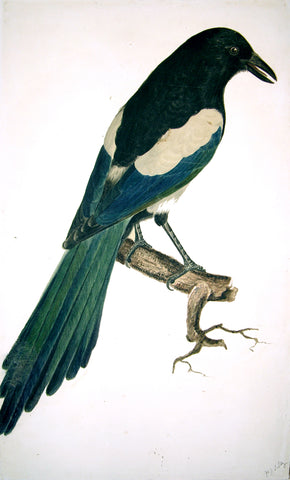
Prideaux John Selby (British, 1788-1867), “Magpie”
Prideaux John Selby (British, 1788-1867)
“Magpie”
Original watercolor prepared for Plate 31 of Illustrations of British Ornithology
Watercolor, gouache, grey and brown washes, pen and black ink on paper
Signed lower right: P.J. Selby
Paper size: 10 x 17 in.
In the fabrication of its nest, the Magpie displays wonderful ingenuity, rendering it not only a sheltered and warm residence for its young, but even a secure fortress against external enemies. The outer part is composed of sticks, lined with a thick plastering of clay, on which is disposed a soft bed of the small fibres of roots and dry grass. Over the body of the nest is erected a covering or dome, composed of the sharpest thorny twigs (those of the black or sloe thorn being generally preferred), closely interwoven, so as to preclude all entrance except at one or two small lateral holes, barely large enough for the admission and egress of the owners. The number of the eggs is from six to eight, of a yellowish-grey colour, speckled with yellowish-brown. The place selected for nidification varies, depending on the facilities afforded, but always with a view to security. Where trees abound, that which is loftiest, or difficult of access, is chosen, and, in failure of these, the most impenetrable hedge or thorn bush. If taken young, it soon becomes tame, and, like others of this genus, may be taught tricks, and the articulation of some words. When alarmed, the Magpie gives warning to all other birds and animals of the approaching danger by its chattering note, the import of which appears to be understood, and universally attended to. In the northern parts of England, the lingering remains of popular superstition still attach to the appearance of this bird, and various are the events predicted from the numbers seen together, their mode of flight, &c. The species is found in most of the temperate and northern regions of the Old Continent; and in Asia, it is met with inhabiting the plains, in Siberia, and as far as Kamtschatka. According to Temminck and Dr Richardson, this bird exhibits also no specific difference in many parts of North America.
Plate 31. Fig. 2. Natural size. Head black, with a small notch at the tip. Irides dark brown. Head, neck, back and breast black. The feathers on the throat very open in the texture, having but few barbs, and terminating with a bristle. Scapulars and belly white. Adjoining the tail-coverts is a bar of greyish-white, loose silky feathers. Rump and vent black. Wings glossed with blue and green reflections. The central parts of the inner webs of the quill-feathers white. First quill-feather very short, the fourth and fifth being the longest. Tail about ten inches in length, bluish-black, glossed with golden-green, blue, and purple, producing in di erent lights the richest iridescent reflections; is very wedge-shaped, the feathers rapidly decreasing in length to the outermost, which are scarcely half the length of the two central feathers, which are even. Legs and claws black. The female resembles the male bird, but is generally inferior in size.”
Considered by many as the English equivalent of Audubon, Prideaux John Selby created some of the most memorable bird images of the nineteenth-century. His contributions to British ornithology were rivaled only by those of John Gould. Yet, his pictures were larger and less purely scientific, exhibiting Selby’s distinctive and charming style. A sense of Selby’s enthusiasm for his subjects is nowhere more palpable than in his engaging original watercolors. Selby executed these delightful images as preparatory models for his landmark printed series, Illustrations of British Ornithology. While the artist’s engraved work is highly desirable to collectors, Selby’s original watercolors rarely become available. This selection of watercolors, moreover, comprises several of his masterpieces. The distinctive birds are depicted in profile, their forms delineated by softly modulated tones of black and gray wash. The setting, if present, is lightly but skillfully painted to not distract from the birds themselves. The skill and delicacy of Selby’s touch, his keen powers of observation, and his artistic sensitivity are conveyed here in a way they are not in his printed work. Several of the drawings are by Selby’s brother-in-law, Robert Mitford, but signed in Selby’s hand.
Born in Northumberland and educated at University College, Oxford, Selby was a landowner and squire with ample time to devote to studying the plant and animal life at his country estate, Twizell House. As a boy, he had studied the habits of local birds, drawn them, and learned how to preserve and set up specimens. Later, Selby became an active member of several British natural history societies and contributed many articles to their journals. Although Selby was interested in botany and produced a History of British Trees in 1842, he is best known for his Illustrations of British Ornithology. Selby’s work was the first attempt to create a set of life-sized illustrations of British birds, remarkable for their naturalism and the delicacy of their execution. The British Ornithology was issued in nineteen parts over thirteen years; the book consisted of 89 plates of land birds and 129 plates of water birds, engraved by William Lizars of Edinburgh, the printer who engraved the first ten plates of Audubon’s Birds of America.
With their rich detail and tonal range, these exquisite watercolors are beautiful works by one of the foremost British bird painters. Furthermore, they represent a singular opportunity to obtain a unique piece of the highest quality by this luminary artist, from an era in British ornithological art that remains unparalleled.
or by email at loricohen@aradergalleries.
We Also Recommend





